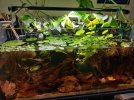datemike
New Member
- Messages
- 16
Hello everyone,
I am outlining a stocking plan for a 75g tank that I have been planting and decorating. When I am finished planting and cycling after about 5-6 weeks, I will be introducing my fish.
Stock Plan:
x10 Pangio Kuhlii (these are introduced first)
x20 Red Eye Tetra (introduced a week and half after the kuhlii)
x1 King Tiger Pleco (introduced same week as tetra)
x5 German Blue Ram (introduced last, ~2 weeks after kuhlii)
My main question:
1. Can I put in a group of Apistogramma in here that would thrive with the rest of the fish and not create a disaster with the rams?
I've read a few posts on here before joining and noticed that people here do indeed keep Apisto with rams, even in smaller tanks than mine like a 55g. My concern here is that I have been getting nothing but conflicting information from the subreddits I've been posting and researching on over at reddit. I've been outright told there's no way you can keep a group of rams with a group of apisto, no matter the size of the tank or the size of the schools. I'm fairly sure this is not correct, so that's why I'm here.
My other questions:
2. What is the ideal temp for the stock plan I have outlined? (Rams thrive around 85-86F but I will likely stick to 80-83F to not stress out the tetra too much, thoughts on this?)
3. What ratio of males to female should I have in my blue ram school? ( after researching I was led to believe 1 male and a 4 female harem would work)
4. If I can include Apisto, what variety would you suggest and what size school and gender ratio?
5. Does anyone have experience with shrimp in their tanks with rams/apisto? I have read posts about people keeping cherry shrimp somehow with rams which sounds hard to believe. I've seen people talk about keeping Amano which are a tad bigger with them successfully as well.
6. What plants are you keeping with your Dwarf Cichlids?
7. Do any of you have any other stocking plan suggestions that you would choose over what I have outlined? I'd love to hear other people's ideas and how they'd set up a tank this size.
INFO:
75G Aqueon
Fluval Stratum
Black Diamond Blasting Sand
Anubias, Java Fern/Moss, Sword Plant, Bacopa
Driftwood+River Rock Ornamentation
I am outlining a stocking plan for a 75g tank that I have been planting and decorating. When I am finished planting and cycling after about 5-6 weeks, I will be introducing my fish.
Stock Plan:
x10 Pangio Kuhlii (these are introduced first)
x20 Red Eye Tetra (introduced a week and half after the kuhlii)
x1 King Tiger Pleco (introduced same week as tetra)
x5 German Blue Ram (introduced last, ~2 weeks after kuhlii)
My main question:
1. Can I put in a group of Apistogramma in here that would thrive with the rest of the fish and not create a disaster with the rams?
I've read a few posts on here before joining and noticed that people here do indeed keep Apisto with rams, even in smaller tanks than mine like a 55g. My concern here is that I have been getting nothing but conflicting information from the subreddits I've been posting and researching on over at reddit. I've been outright told there's no way you can keep a group of rams with a group of apisto, no matter the size of the tank or the size of the schools. I'm fairly sure this is not correct, so that's why I'm here.
My other questions:
2. What is the ideal temp for the stock plan I have outlined? (Rams thrive around 85-86F but I will likely stick to 80-83F to not stress out the tetra too much, thoughts on this?)
3. What ratio of males to female should I have in my blue ram school? ( after researching I was led to believe 1 male and a 4 female harem would work)
4. If I can include Apisto, what variety would you suggest and what size school and gender ratio?
5. Does anyone have experience with shrimp in their tanks with rams/apisto? I have read posts about people keeping cherry shrimp somehow with rams which sounds hard to believe. I've seen people talk about keeping Amano which are a tad bigger with them successfully as well.
6. What plants are you keeping with your Dwarf Cichlids?
7. Do any of you have any other stocking plan suggestions that you would choose over what I have outlined? I'd love to hear other people's ideas and how they'd set up a tank this size.
INFO:
75G Aqueon
Fluval Stratum
Black Diamond Blasting Sand
Anubias, Java Fern/Moss, Sword Plant, Bacopa
Driftwood+River Rock Ornamentation
